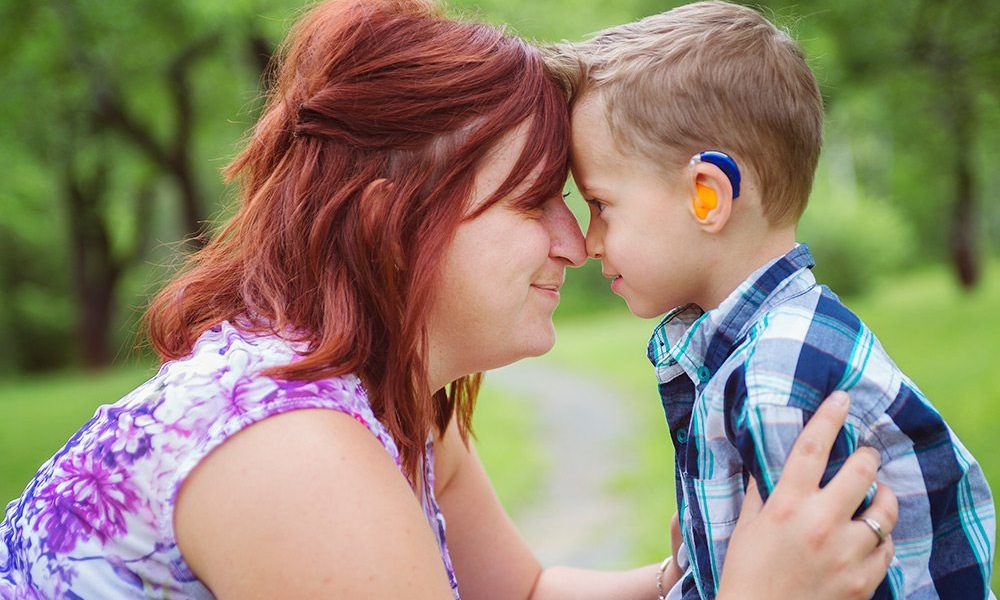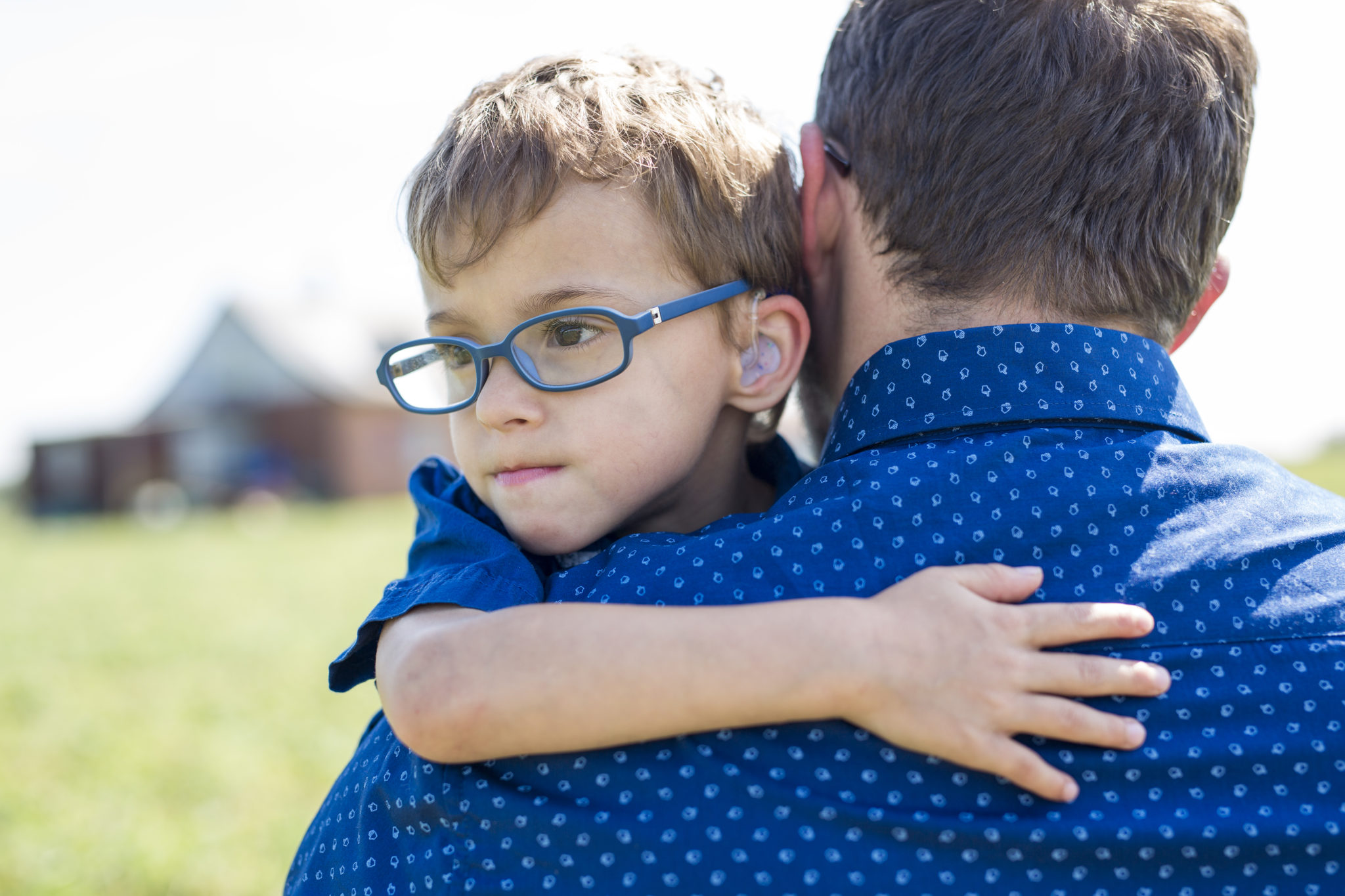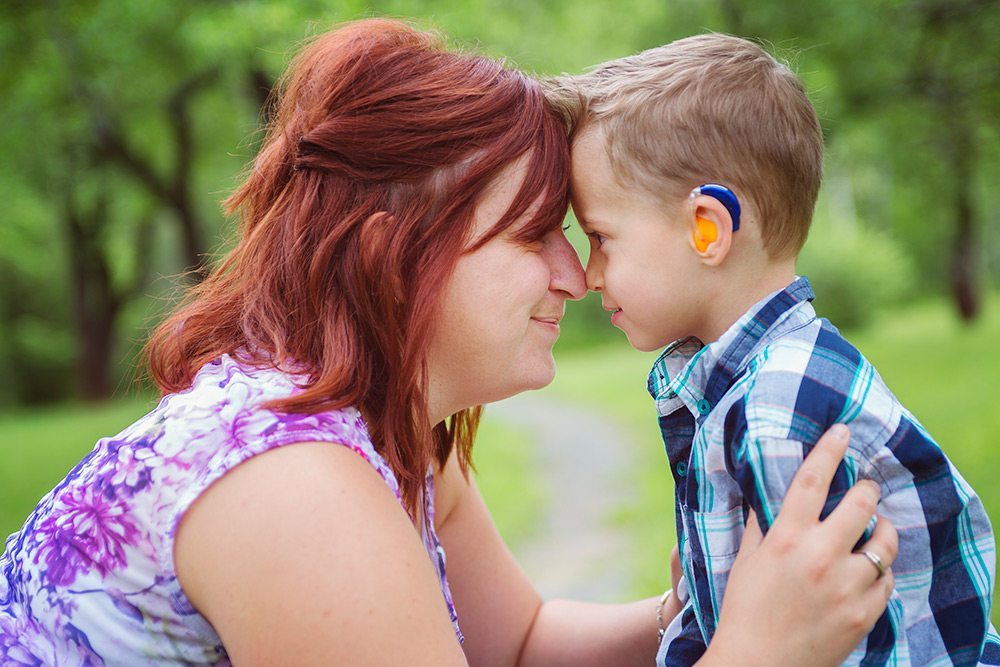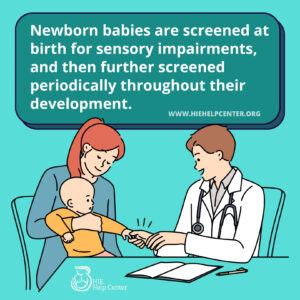 The impacts of hypoxic-ischemic encephalopathy (HIE) may cause a child to develop subsequent vision and/or hearing impairments. Generally, newborn babies are screened at birth for sensory impairments, and then further screened periodically throughout their development (1, 2). If parents have concerns about vision and/or hearing, they can speak to their child’s pediatrician.
The impacts of hypoxic-ischemic encephalopathy (HIE) may cause a child to develop subsequent vision and/or hearing impairments. Generally, newborn babies are screened at birth for sensory impairments, and then further screened periodically throughout their development (1, 2). If parents have concerns about vision and/or hearing, they can speak to their child’s pediatrician.
Their pediatrician may then refer them to specialists such as ophthalmologists (for vision evaluation and care) or audiologists and otolaryngologists (for hearing evaluation and care) (1). These medical professionals can provide recommendations regarding what kind of interventions the child will need – sometimes this may involve glasses or a hearing aid, though there are certain circumstances in which surgical intervention may be appropriate.
Jump to:
- Common vision impairments associated with HIE
- Common hearing impairments associated with HIE
- What signs may indicate that my child has a vision or hearing impairment?
- When should my child be referred to a vision or hearing specialist?
- About HIE Help Center
- Sources
Common vision impairments associated with HIE
Cortical Visual Impairment (CVI)
Also known as cortical blindness or cerebral visual impairment, this type of vision loss can be caused by damage to the brain and pathways between the eye and the brain. The eyes themselves are often normal, but visual impairment ranges from mild to severe. Hypoxia (oxygen deprivation) is the most common cause of CVI (5).
Tunnel vision
This involves the loss of peripheral vision, typically due to conditions that impact the function of rods in the retina. People with tunnel vision cannot see objects unless they are near the center of their visual field (6).
Strabismus
The eyes of people with strabismus are misaligned, and point in different directions (some cases are more obvious than others). Strabismus is often caused by brain damage, which impacts the muscles that control eye movement. Children who have strabismus may develop amblyopia (vision impairment) in the misaligned eye. The brain will learn to only pay attention to visual input from the straighter/stronger eye. This can cause them to lose depth perception. If amblyopia is detected early in life, it can be treated by putting a patch over the stronger eye to improve vision in the weaker eye. If it is not caught early, it is more likely to become permanent (7).
Common hearing impairments associated with HIE
Babies with HIE are at risk for sensorineural hearing loss (SNHL) (8), which involves damage to the inner ear or pathways between the brain and inner ear (9).Whether SNHL is temporary or permanent depends in part on the duration and severity of the oxygen deprivation the infant experienced (8). If sensorineural hearing loss is permanent, it can sometimes be managed with hearing aids. People with sensorineural hearing loss may also be eligible for cochlear implants (9).
What signs may indicate a child has a vision or hearing impairment?
The following indications are general; they may apply to children with and without HIE.
Signs and symptoms of visual impairment (10):
- Problems tracking objects (in infants over three months)
- Misaligned eyes/strabismus (in infants over four months; younger than that, it is common for babies’ eyes to occasionally appear misaligned)
- White/light gray coloration in the pupil
- Fluttering eyes
- Redness that doesn’t go away after a few days
- Pus/crustiness
- Consistently watery eyes
- Eyelid drooping
- Sensitivity to light
- The child complains of eye pain or itchiness
Signs and symptoms of hearing impairment (11):
- Not startling at loud noises
- Not turning towards the source of a sound (this is concerning if it occurs after six months of age)
- By one year of age, not saying simple words like “mama” and “dada”
- Speech delays/problems
- Difficulty following directions
- Turning up TV volume unusually high
- Saying “huh?” or asking someone to repeat something often
When should a child with HIE be referred to a vision or hearing specialist?
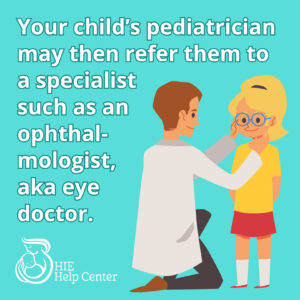 There are certain HIE-associated diagnoses which indicate that a child’s pediatrician should refer them to a specialist (12):
There are certain HIE-associated diagnoses which indicate that a child’s pediatrician should refer them to a specialist (12):
Indications for early referral to an ophthalmologist:
- If a child has Stage III HIE
- If a child has Stage II HIE with either abnormal findings from a neurological examination or reduced visual awareness at the time of discharge from the hospital
- If a child has an HIE-associated stroke
Indications for early assessment of sensorineural hearing:
- If a child has intrapartum asphyxia, they should be tested for sensorineural hearing loss after birth and before they are discharged from the hospital.
- If the child has persistent pulmonary hypertension of the newborn (a serious circulation problem) along with HIE, they should be tested repeatedly throughout childhood because they may be at higher risk of late-onset sensorineural hearing loss.
Vision and hearing are critical for a child’s development, as they are two of the most important senses through which a child perceives the world. When children show early signs of impairment in vision or hearing, pediatricians should refer them to specialists such as opthamologists, audiologists, and otolaryngologists. Theses specialists can make recommendations for early interventions to help maximize a child’s abilities.
About HIE Help Center
The HIE Help Center is run by ABC Law Centers, a medical malpractice firm that has been exclusively handling cases involving HIE and other birth injuries since the firm’s inception in 1997.
If you suspect your child’s HIE may have been caused by medical negligence, contact us to learn more about pursuing a case. We provide free legal consultations, during which we will inform you of your legal options and answer any questions you have. Moreover, you would pay nothing throughout the entire legal process unless we obtain a favorable settlement.
Sources:
- Newborn Hearing Screening FAQs. (2023, August 28). Retrieved May 15, 2024, from https://www.healthychildren.org/English/ages-stages/baby/Pages/Purpose-of-Newborn-Hearing-Screening.aspx
- Vision Screenings. (2022, March 31). Retrieved May 15, 2024, from https://www.healthychildren.org/English/health-issues/conditions/eyes/Pages/Vision-Screenings.aspx
- Alexander, P. K. (1990). The Effects of Brain Damage on Visual Functioning in Children[PDF]. Journal of Visual Impairment and Blindness.
- Malkowicz, D. E., Myers, G., & Leisman, G. (2006). Rehabilitation of cortical visual impairment in children. International journal of neuroscience, 116(9), 1015-1033.
- Cortical Visual Impairment (CVI). (n.d.). Retrieved May 14, 2024, from https://nei.nih.gov/faqs/cortical-visual-impairment-cvi
- Tunnel vision. (n.d.). Retrieved May 14, 2024, from https://www.uclahealth.org/eye/tunnel-vision
- Strabismus Causes. (2023, November 13). Retrieved May 15, 2024, from https://www.aao.org/eye-health/diseases/strabismus-cause
- Hearing loss in term newborn infants with hypoxic-ischemic encephalopathy treated with therapeutic hypothermia.pdf. (n.d.). Retrieved May 14, 2024, from https://www.scribd.com/document/253542548/Hearing-loss-in-term-newborn-infants-with-hypoxic-ischemic-encephalopathy-treated-with-therapeutic-hypothermia-pdf
- Sensorineural Hearing Loss. (n.d.). Retrieved May 15, 2024, from https://www.asha.org/public/hearing/Sensorineural-Hearing-Loss/
- Warning Signs of Vision Problems in Infants & Children. (2016, July 19). Retrieved May 15, 2024, from https://www.healthychildren.org/English/health-issues/conditions/eyes/Pages/Warning-Signs-of-Vison-Problems-in-Children.aspx
- What is Hearing Loss in Children? | CDC. (n.d.). Retrieved May 29, 2019, from https://www.cdc.gov/hearing-loss-children/about/?CDC_AAref_Val=https://www.cdc.gov/ncbddd/hearingloss/facts.html
- Robertson, C. M., & Perlman, M. (2006). Follow-up of the term infant after hypoxic-ischemic encephalopathy. Paediatrics & child health, 11(5), 278-282.

